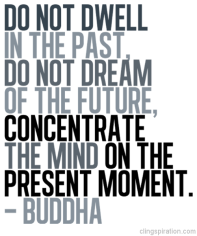 …is one of the greatest – and most difficult – things I’ve come to practise. Not only did it take me many years to simply understand and learn how to do it, but it also took a long time before I truly implemented it into my daily life. Until I truly lived it! Although I moved forward, learned and evolved a great deal during all those years – not only on my individual spiritual journey but also as being part of this world – I simply wasn’t really “ready” to master the art of mindfulness. If that’s possible at all. It is not until the later years of my life when I’ve gotten even more spiritually inspired by the beautiful souls I’ve been blessed with in my life. that I have come to somehow grasp the fascinating art of practising mindfulness.
…is one of the greatest – and most difficult – things I’ve come to practise. Not only did it take me many years to simply understand and learn how to do it, but it also took a long time before I truly implemented it into my daily life. Until I truly lived it! Although I moved forward, learned and evolved a great deal during all those years – not only on my individual spiritual journey but also as being part of this world – I simply wasn’t really “ready” to master the art of mindfulness. If that’s possible at all. It is not until the later years of my life when I’ve gotten even more spiritually inspired by the beautiful souls I’ve been blessed with in my life. that I have come to somehow grasp the fascinating art of practising mindfulness.
A (big) part of mindfulness is the art of meditation. Some say that mindfulness is a type of meditation. And I can agree on that, in the way it’s practitioner focuses his/hers mind on the present moment. To be mindful is partly being aware and non-judgmental of ones thoughts and actions in the present Now. I find that being mindful – or by practising mindfulness if you wish – is however broader than simply practising meditation as it includes having a “mindfulness attitude.” By having a “mindfulness attitude” you also – apart from practising non-judging – get to practise patience, trust, non-striving, acceptance, non-attachment and what is commonly refereed to as “beginners mind”. All these parts of mindfulness is a subject for another time though. Back to meditation…
…the British philosophical author James Allen called meditation
“[…] a special kind of dance in which we commit ourselves wholeheartedly to the practice of deconstructing the materialistic view of reality.” In his book “The way of peace” Allen discusses not only the purpose of meditation but also the importance of practising it in a truthful (for yourself) manner. Allen stated that “[…] the challenge is simultaneously to hold on and to let go; it is to see clearly what we are doing and at the same time see through it. To do this, it’s important to cultivate a feeling for the Middle Way. This is the balance point. […] I therefore encourage everyone to recognize that every technique, every form of expression is just a convention that we’re picking up and using for a single goal: to transcend suffering and to be liberated. That’s what any technique points us toward. […] We can simply ask ourselves, ‘Am I experiencing dukkha? Is there a feeling of alienation or difficulty?’ If there is, it means that we are clinging or hanging on to something. We need to see that the heart is attached somewhere and then make the gesture to loosen up, to let go. Sometimes we don’t notice where the suffering gets generated. We get so used to doing things in a particular way that we take it as a standard. But in meditation, we challenge the status quo. We investigate where there is a feeling of ‘dis-ease’ and look to see what’s causing it. By stepping back and scanning the inner domain, it’s possible to find out where the attachment is and what’s causing it. Ajahn Chah would say, ‘If you have an itch on your leg, you don’t scratch your ear.’ In other words, go to where the dukkha is, no matter how subtle it may be; notice it and let go. That’s how we allow the dukkha to disperse. This is how we will know whether the practices we are doing are effective or not […]”.
Related articles
- Vipassana Meditation (buddhajourney.wordpress.com)
- Challenge 1: Meditate Vipassana style (nurturinghappiness.wordpress.com)


The distinction or perhaps relationship between mindfulness and meditation is a really interesting one. Does one lead to the other, or vice versa? Love this quote, thanks for sharing.